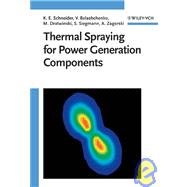
Note: Supplemental materials are not guaranteed with Rental or Used book purchases.
Purchase Benefits
Looking to rent a book? Rent Thermal Spraying for Power Generation Components [ISBN: 9783527313372] for the semester, quarter, and short term or search our site for other textbooks by Schneider, Klaus Erich; Belashchenko, Vladimir; Dratwinski, Marian; Siegmann, Stephan; Zagorski, Alexander. Renting a textbook can save you up to 90% from the cost of buying.
Vladimir Belashchenko has a PhD in Physics and Chemistry of Plasma Technology and a ScD in Materials Science. He has over 30 years of experience in research, development and implementation of thermal spray equipment, materials and technologies. In 1992, he obtained the ASM International Award, in 2004 the R&D 100 Award.
Marian Dratwinski is a process development engineer with a very wide range of technical knowledge and experiences. In his current post, he is responsible for Coating Applications Development at Sulzer Metco AG in Switzerland.
Stephan Siegmann received his degree in Physics from the University of Basel, Switzerland. After completing the PhD in the field of Thermal Spraying, he was working as Vice Manager Research at MGC Plasma Company at Muttenz, Switzerland, in the field of waste treatment by thermal plasma at 1.2 MW. In the year 1994 he changed back to his former fi eld of Thermal Spraying and built up a position at the Swiss Federal Institute for Materials Science and Technology (EMPA), where he is now responsible for all Thermal Spray activities.
Alexander Zagorski received his degree in Mechanical Engineering from the Novosibirsk State Technical University and his PhD in Hydromechanics and Plasma from the Institute of Theoretical and Applied Mechanics in Novosibirsk, Russia. After having worked in Research and Development for eighteen years, he is now the Expert Engineer at the ALSTOM Customer Service Development in Switzerland.
|
|||
|
|||
|
|||
|
|||
|
|||
|
|||
|
|||
|
|||
|
|||
|
|||
|
|||
|
|||
|
|||
|
|||
|
|||
|
|||
|
|||
|
|||
|
|||
|
|||
|
|||
|
|||
|
|||
|
|||
|
|||
|
|||
|
|||
|
|||
|
|||
|
|||
|
|||
|
|||
|
|||
|
|||
|
|||
|
|||
|
|||
|
|||
|
|||
|
|||
|
|||
|
|||
|
|||
|
|||
|
|||
|
|||
|
|||
|
|||
|
|||
|
|||
|
|||
|
|||
|
|||
|
|||
|
|||
|
|||
|
|||
|
|||
|
|||
|
|||
|
|||
|
|||
|
|||
|
|||
|
|||
|
|||
|
|||
|
|||
|
|||
|
|||
|
|||
|
|||
|
|||
|
|||
|
|||
|
|||
|
|||
|
|||
|
|||
|
|||
|
|||
|
|||
|
|||
|
|||
|
|||
|
|||
|
|||
|
|||
|
|||
|
|||
|
|||
|
|||
|
|||
|
|||
|
|||
|
|||
|
|||
|
|||
|
|||
|
|||
|
|||
|
|||
|
|||
|
|||
|
|||
|
|||
|
|||
|
|||
|
|||
|
|||
|
|||
|
|||
|
|||
|
|||
|
|||
|
|||
|
|||
|
|||
|
|||
|
|||
|
|||
|
|||
|
|||
|
|||
|
|||
|
|||
|
|||
|
|||
|
|||
|
|||
|
|||
|
|||
|
|||
|
|||
|
|||
|
|||
|
|||
|
|||
|
|||
|
|||
|
|||
|
|||
|
|||
|
|||
|
|||
|
|||
|
|||
|
|||
|
|||
|
|||
|
|||
|
|||
|
|||
|
|||
|
|||
|
|||
|
|||
|
|||
|
|||
|
|||
|
|||
|
|||
|
|||
|
|||
|
|||
|
|||
|
|||
|
|||
|
|||
|
|||
|
|||
|
|||
|
|||
|
|||
|
|||
|
The New copy of this book will include any supplemental materials advertised. Please check the title of the book to determine if it should include any access cards, study guides, lab manuals, CDs, etc.
The Used, Rental and eBook copies of this book are not guaranteed to include any supplemental materials. Typically, only the book itself is included. This is true even if the title states it includes any access cards, study guides, lab manuals, CDs, etc.